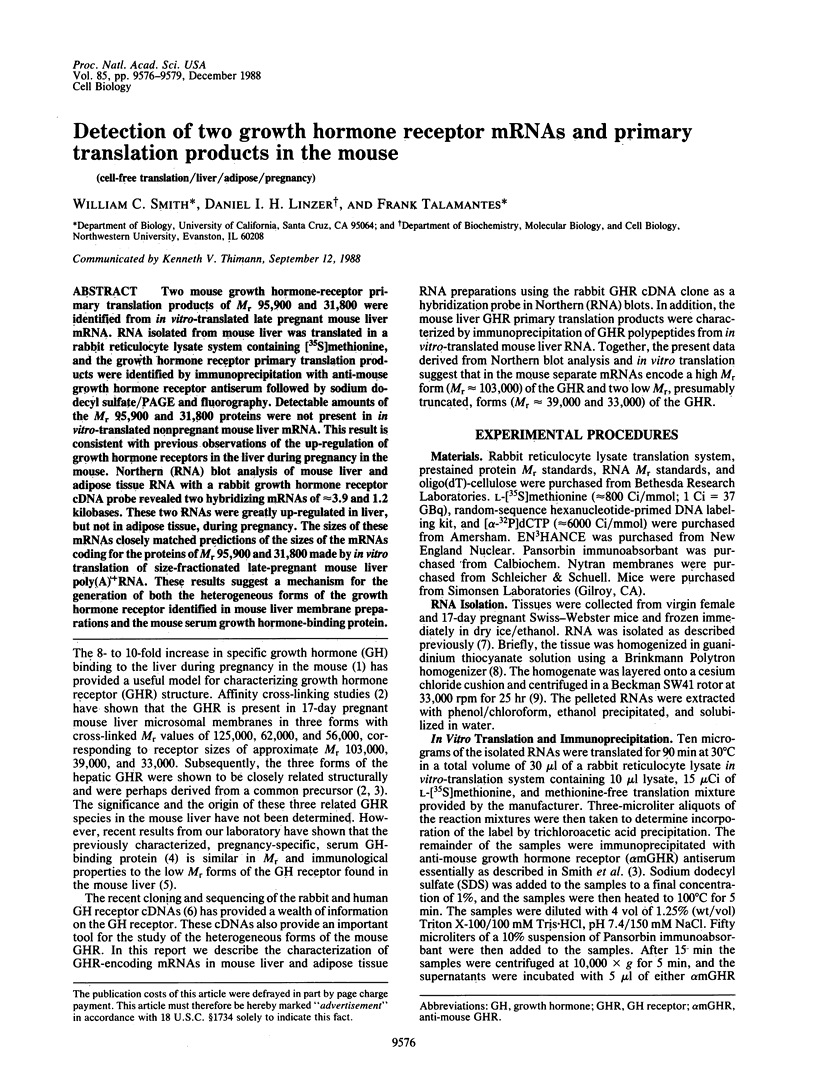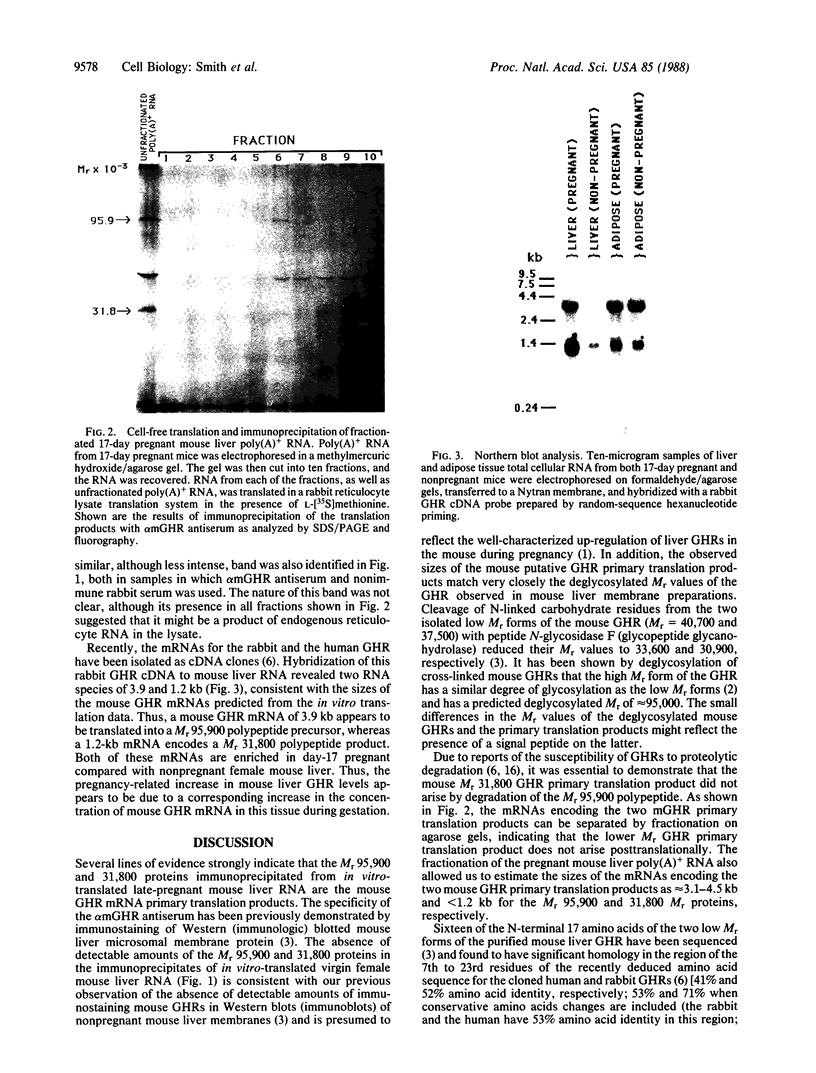Abstract
Two mouse growth hormone-receptor primary translation products of Mr 95,900 and 31,800 were identified from in vitro-translated late pregnant mouse liver mRNA. RNA isolated from mouse liver was translated in a rabbit reticulocyte lysate system containing [35S]methionine, and the growth hormone receptor primary translation products were identified by immunoprecipitation with anti-mouse growth hormone receptor antiserum followed by sodium dodecyl sulfate/PAGE and fluorography. Detectable amounts of the Mr 95,900 and 31,800 proteins were not present in in vitro-translated nonpregnant mouse liver mRNA. This result is consistent with previous observations of the up-regulation of growth hormone receptors in the liver during pregnancy in the mouse. Northern (RNA) blot analysis of mouse liver and adipose tissue RNA with a rabbit growth hormone receptor cDNA probe revealed two hybridizing mRNAs of approximately 3.9 and 1.2 kilobases. These two RNAs were greatly up-regulated in liver, but not in adipose tissue, during pregnancy. The sizes of these mRNAs closely matched predictions of the sizes of the mRNAs coding for the proteins of Mr 95,900 and 31,800 made by in vitro translation of size-fractionated late-pregnant mouse liver poly(A)+RNA. These results suggest a mechanism for the generation of both the heterogeneous forms of the growth hormone receptor identified in mouse liver membrane preparations and the mouse serum growth hormone-binding protein.
Full text
PDF



Images in this article
Selected References
These references are in PubMed. This may not be the complete list of references from this article.
- Aviv H., Leder P. Purification of biologically active globin messenger RNA by chromatography on oligothymidylic acid-cellulose. Proc Natl Acad Sci U S A. 1972 Jun;69(6):1408–1412. doi: 10.1073/pnas.69.6.1408. [DOI] [PMC free article] [PubMed] [Google Scholar]
- Chirgwin J. M., Przybyla A. E., MacDonald R. J., Rutter W. J. Isolation of biologically active ribonucleic acid from sources enriched in ribonuclease. Biochemistry. 1979 Nov 27;18(24):5294–5299. doi: 10.1021/bi00591a005. [DOI] [PubMed] [Google Scholar]
- Feinberg A. P., Vogelstein B. A technique for radiolabeling DNA restriction endonuclease fragments to high specific activity. Anal Biochem. 1983 Jul 1;132(1):6–13. doi: 10.1016/0003-2697(83)90418-9. [DOI] [PubMed] [Google Scholar]
- Fielder P. J., Talamantes F. The lipolytic effects of mouse placental lactogen II, mouse prolactin, and mouse growth hormone on adipose tissue from virgin and pregnant mice. Endocrinology. 1987 Aug;121(2):493–497. doi: 10.1210/endo-121-2-493. [DOI] [PubMed] [Google Scholar]
- Glisin V., Crkvenjakov R., Byus C. Ribonucleic acid isolated by cesium chloride centrifugation. Biochemistry. 1974 Jun 4;13(12):2633–2637. doi: 10.1021/bi00709a025. [DOI] [PubMed] [Google Scholar]
- Jackson L. L., Colosi P., Talamantes F., Linzer D. I. Molecular cloning of mouse placental lactogen cDNA. Proc Natl Acad Sci U S A. 1986 Nov;83(22):8496–8500. doi: 10.1073/pnas.83.22.8496. [DOI] [PMC free article] [PubMed] [Google Scholar]
- Laemmli U. K. Cleavage of structural proteins during the assembly of the head of bacteriophage T4. Nature. 1970 Aug 15;227(5259):680–685. doi: 10.1038/227680a0. [DOI] [PubMed] [Google Scholar]
- Lehrach H., Diamond D., Wozney J. M., Boedtker H. RNA molecular weight determinations by gel electrophoresis under denaturing conditions, a critical reexamination. Biochemistry. 1977 Oct 18;16(21):4743–4751. doi: 10.1021/bi00640a033. [DOI] [PubMed] [Google Scholar]
- Leung D. W., Spencer S. A., Cachianes G., Hammonds R. G., Collins C., Henzel W. J., Barnard R., Waters M. J., Wood W. I. Growth hormone receptor and serum binding protein: purification, cloning and expression. Nature. 1987 Dec 10;330(6148):537–543. doi: 10.1038/330537a0. [DOI] [PubMed] [Google Scholar]
- Peeters S., Friesen H. G. A growth hormone binding factor in the serum of pregnant mice. Endocrinology. 1977 Oct;101(4):1164–1183. doi: 10.1210/endo-101-4-1164. [DOI] [PubMed] [Google Scholar]
- Posner B. I. Characterization and modulation of growth hormone and prolactin binding in mouse liver. Endocrinology. 1976 Mar;98(3):645–654. doi: 10.1210/endo-98-3-645. [DOI] [PubMed] [Google Scholar]
- Smith W. C., Colosi P., Talamantes F. Isolation of two molecular weight variants of the mouse growth hormone receptor. Mol Endocrinol. 1988 Feb;2(2):108–116. doi: 10.1210/mend-2-2-108. [DOI] [PubMed] [Google Scholar]
- Smith W. C., Talamantes F. Gestational profile and affinity cross-linking of the mouse serum growth hormone-binding protein. Endocrinology. 1988 Sep;123(3):1489–1494. doi: 10.1210/endo-123-3-1489. [DOI] [PubMed] [Google Scholar]
- Smith W. C., Talamantes F. Identification and characterization of a heterogeneous population of growth hormone receptors in mouse hepatic membranes. J Biol Chem. 1987 Feb 15;262(5):2213–2219. [PubMed] [Google Scholar]
- Thomas P. S. Hybridization of denatured RNA and small DNA fragments transferred to nitrocellulose. Proc Natl Acad Sci U S A. 1980 Sep;77(9):5201–5205. doi: 10.1073/pnas.77.9.5201. [DOI] [PMC free article] [PubMed] [Google Scholar]
- Yamada K., Lipson K. E., Donner D. B. Structure and proteolysis of the growth hormone receptor on rat hepatocytes. Biochemistry. 1987 Jul 14;26(14):4438–4443. doi: 10.1021/bi00388a037. [DOI] [PubMed] [Google Scholar]





